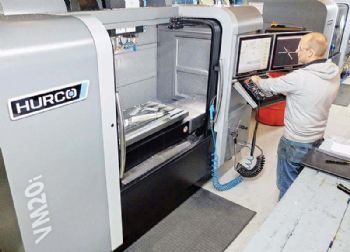
Almost every component machined on the five Hurco three-axis machining centres at the Scottish sub-contractor Euro Precision is programmed on the shopfloor with the assistance of ‘user-friendly’ menus in the machine tool builder’s proprietary WinMAX control software.
If a profile is relatively complex, as is the case with about half the components machined, it is imported as a DXF file generated in CAD, which the Hurco control reads directly.
Sometimes, the NC Merge feature within the control software is used, and conversational cycles programmed via the CNC touch-screens are combined with data blocks created in an off-line CAM system to define the more-intricate 3-D features of a component.
Euro Precision’s production manager, Mark Ramsay, said: “The Hurco software is very versatile, easy to use and fast at producing three-axis prismatic machining cycles.
“This capability means all our quick-turnround work that requires a lead time of — say — two weeks goes through these machines.

“We simply take a drawing down to one of our setter-operators, who will very often have the job running with-in an hour; this is faster than if we had to wait for our off-line programming department to produce the program using our Esprit CAM system, as there is usually a backlog of work for our five-axis machines.”
Established in Auchterarder more than 25 years ago as Technicut by Liam Torrance, who in 2009 took over Qualtronic (located in what are now Euro Precision’s 30,000ft
2 premises in Glenrothes), Euro Precision specialises in supplying complex precision components and assemblies; these are mainly machined from aluminium but also from stainless steel and steel in batch sizes that are typically one- to 30-off — but sometimes into the thousands.
Customers are from a variety of industry sectors, including aerospace, automotive, defence, electronics, energy, medical and telecommunications.
Necessary investment
The current ‘tally’ of Hurco machining centres at the sub-contractor’s production facility includes a VM1, a VM2 and a VMX24 with the Ultimax control system — the predecessor of the WinMAX twin-screen control.
These machines, which were previously in use at Technicut, have been joined by a VM30i (installed in 2015) and a VM20i (with a fourth axis) that was bought last year.
The latter purchase was dictated by the need for extra capacity to meet an upturn in demand, particularly from customers in the aerospace and automotive sectors, as well as those producing automation machines for the medical and fast-moving consumer goods industries.
Ian Blues, a setter-operator at Euro Precision, said: “The WinMAX control is very easy to use; in fact, you can learn to use it straight from the manual, although we had three days of on-site training from Hurco on our latest machine.

“There are also some particularly useful features in the software, such as the way hole patterns can be copied and repeated; and there is the ‘loop linear’ routine that repeats a pattern a specified number of times along a line defined in the X-Y plane.
“Moreover, all the Hurcos hold our usual tolerances of ±20µm — although an experienced operator can achieve a quarter of that.”
Mr Blues highlights the example of an underwater-camera housing that is milled and drilled on the VMX30i from solid aluminium (on the top and sides) in two operations in a cycle time of 80min — half of which was taken up by engraving lettering imported via DXF.
Inspection on a co-ordinate measuring machine verified that 5µm flatness plus 20µm parallelism and perpendicularity are achieved.
Another example of DXF input that he cited involves the complex pockets of an aerospace component with a 0.8mm base thickness.
This part was designed in BobCad running on a PC on the shopfloor, but Hurco software ensured that there were no errors when transferring the profiles.
An example of where NC Merge proved useful was the production of another aerospace part.
In this case, the basic 2-D shape of a lifting frame was programmed conversationally in WinMAX, but a DXF file was imported to define the draft angle of four radial arms.
In conclusion, Mr Torrance said: “Over the years, we have developed a reputation for customer service as well as quality, reliability and flexibility.
“The conversational shopfloor capabilities of our Hurco machines have helped us to deliver on those commitments right from the start and continue to do so, especially with the enhanced capabilities of the latest WinMAX software.”